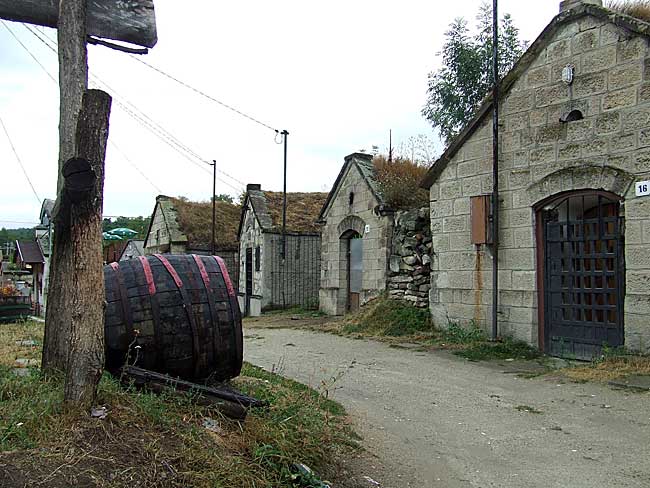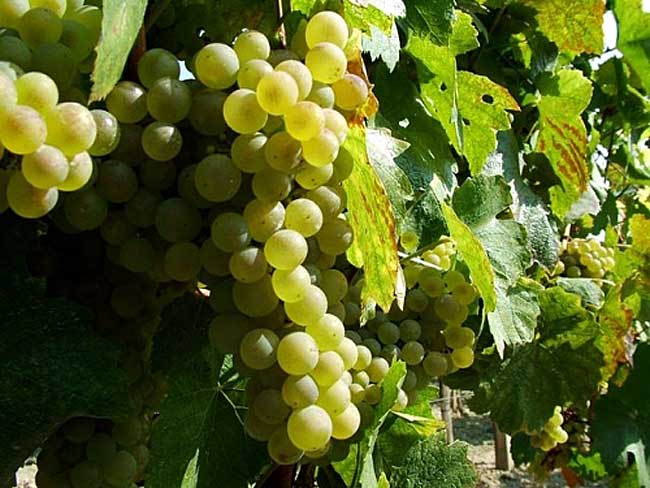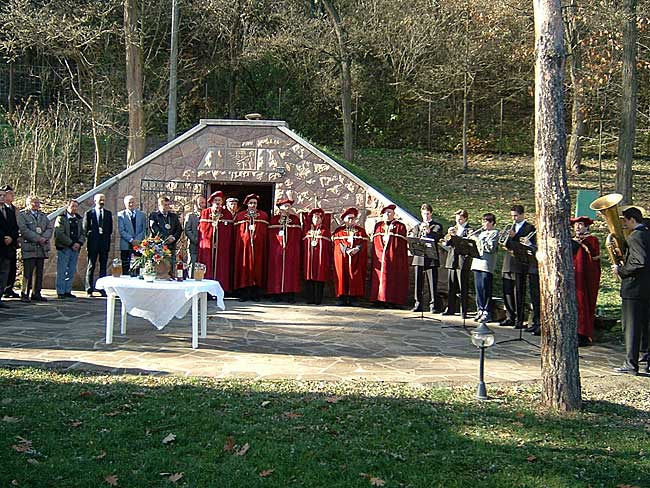 The wine cellars in Cserépi Road are popular venues for several events – but they are also worth visiting just to taste their treasureBogács is one of the most typical settlements of the Bükk wine region, a member of the Bükkalja Wine Route Association. Its wines can be compared to the ones made in Eger, but the acidity of the latter is a bit lower. In the intimate wine cellars sitting in the nearby hills wine is usually produced with a traditional oxydative method. Saint Martin Wine Order plays a big part in preserving and creating values.
The wine cellars in Cserépi Road are popular venues for several events – but they are also worth visiting just to taste their treasureBogács is one of the most typical settlements of the Bükk wine region, a member of the Bükkalja Wine Route Association. Its wines can be compared to the ones made in Eger, but the acidity of the latter is a bit lower. In the intimate wine cellars sitting in the nearby hills wine is usually produced with a traditional oxydative method. Saint Martin Wine Order plays a big part in preserving and creating values.
The Bükk wine region
24 settlements belong to this wine region. Its soil is mostly loess formed through the weathering of rhyolite tuff. This area is rich in sunshine but poor in precipitation and the temperature is a bit cooler than the Hungarian average. Thus this land is suitable for producing white wines. The wines made here are usually light with a noticeable sense of acidity, thin and fruity. In the small wineries wines are usually made with an oxidative technique, however bigger wineries make reductive wines from white grapes, but rosé and barrique, as well.
Typical types of grapes
White: Riesling, Chardonnay, Cserszegi fueszeres, Leanyka, Muller-Thurgau, Tramini, Ottonel muscatel
Blue: Kékfrankos (Blue Frankish), Cabernet sauvignon, Cabernet franc, Merlot, Zweigelt, Pinot noir
Wine Route
In 2002 the Bükkalja Wine Route Association was created. It is based in Tibolddaróc and its members are trying to make the Bükk wine region ranked as high as the famous, top wine regions.
A little history
 Fox grape was a native plant in the Hungarian Mountains, even cavemen had known it since the end of the ice age. However, very little is known about how and when viticulture began. In 1313 it was first mentioned in a charter. The text about grapes and their growing suggested that viticulture was a very important part of local agriculture at that time.
Fox grape was a native plant in the Hungarian Mountains, even cavemen had known it since the end of the ice age. However, very little is known about how and when viticulture began. In 1313 it was first mentioned in a charter. The text about grapes and their growing suggested that viticulture was a very important part of local agriculture at that time.
In the 7th century the main grape types were: Goher, Furmint, Hárslevelű, Bátai, Demjén and Fejérszőlő. In the 9th and 10th centuries Tibolddaróc was considered to be a famous region for making the basis of the sparkling wine. For this they used Furmint or Riesling.
In the last century Bükkalja belonged to the Miskolc wine region, it has only been independent since 1970. In the most significant settlements of the region – Bogács, Cserépfalu and Tibolddaróc – cellars have been built on a large scale. The cellars have been expanded and modernised in accordance with the official regulations and the growing demands of the tourist industry.
Saint Martin Wine Order
 The wine order was founded in 1996. The name refers to the patron saint of the church of Bogács. On 11th November, on the name day of Saint Martin (Márton) a festival is held, during which the new wine is tasted and blessed. The members of the wine order wear a crimson uniform. They have spread the news and good reputation of this region not only in Hungary but also in Austria and Germany thus enhancing international relations.
The wine order was founded in 1996. The name refers to the patron saint of the church of Bogács. On 11th November, on the name day of Saint Martin (Márton) a festival is held, during which the new wine is tasted and blessed. The members of the wine order wear a crimson uniform. They have spread the news and good reputation of this region not only in Hungary but also in Austria and Germany thus enhancing international relations.
It is the responsibility of the members of the wine order to widely propagate the beauty and values of the gynaeceum, to preserve and improve the traditions of viticulture and oenology, to promote the cultivated indulgence in wine, to start the tradition of so-called cellar events through interesting programmes and to establish, maintain and expand international connections.
The leading wine of Bogács is the Riesling. According to the wine-growers of Bogács and Bükkalja this drink is the king of Hungarian wines. This wine makes you love life. In this wine you can taste the wisdom that Hungarians can learn from wine: you must love life. Riesling does not only have a unique flavour, fragrance and high alcohol content but above all it has soul. In this wine you can taste the wisdom of the East, the calmness of Asia and the education and curiosity of the West. This is the best combination in wine and in a person, too.
The words of the oath:
„In front of the present members of the Saint Martin Wine Order and the numerous wine-lovers I, .................... hereby solemnly swear that with all my conviction I will spread the reputation of the Bükkalja wines, especially the Bogács Riesling, which can heal the heart and the soul, and make the spirit soar.
As a member of the Saint Martin Wine Order of Bogács I promise to be a worthy part of this illustrious corp. I will not harm it; on the contrary, I will contribute to its good reputation. I will never forget that the greatest respect is paid to the bent man cultivating grapes, so wherever I find myself in the world, if I have a wine glass in my hand, I will always drink this noble drink to honour wine-growers."
The legend of the life-saving wine of Bogács
Not only the present residents of the Bükkalja region are delighted by the colour and flavour of the Riesling, it was the same centuries ago, too. The grapes grew on their hills in long rows, the wine quenched their thirst and crowned their festivals. What is more, it saved lives during the Turkish invasion! Although the resourcefulness of a young man from Bogács was also necessary for this...
According to the legend, quite a big group separated from the huge Turkish army marching against Eger and “popped in” to see Bogács. They stole livestock, but fortunately at that time all the locals were in Jács Valley, where they were having a party to say farewell to the men going into battle in Eger. After the villagers had heard the news they had some time to make sticks and come up with a plan. They lured the Turks up to Kőkötő (a quarry), where they threw stones at them making them flee – however it was obvious that only for one day.
The next day the champion of the village, Barna the Valiant had a plan: the women, the children and the old should hide in the wine cellars. However, that much even the Turks could have found out, so he also devised how to make the cellars invisible. The men would pull down the front of each wine cellar, then through a secret opening in the woods they join the others inside. Not everybody liked this plan, but for lack of a better one, that was what they did.
The Turks did not find them! But they didn’t leave either, they set up camp in the woods. Two weeks passed. The locals of Bogács had air to breathe in those small places, but were running out of food and water very quickly. Barna the Valiant then ordered the following: adults could only drink wine, water was only available for the children – but even so it was mixed with a little Riesling. Not very easily but they were able to hold on for two more weeks without anyone getting sick. At the end of the fourth week Barna the Valiant, who had been watching the Turks daily, saw that another small group of riders had arrived. The newcomers didn’t stay, however, but took the 500 Turkish soldiers camping in the woods with them! As it turned out later by that time their absence had been noticed in Eger, so they were ordered to join the siege immediately.
This way the locals of Bogács were rescued. They were able to come out of the cellars and on Saint Martin’s name day they celebrated the wedding of Barna the Valiant and his beautiful love, Borbála. They continued growing their beloved grape and making tasty wines in the cellars
(on the basis of Imre Hajdu’s documents)





